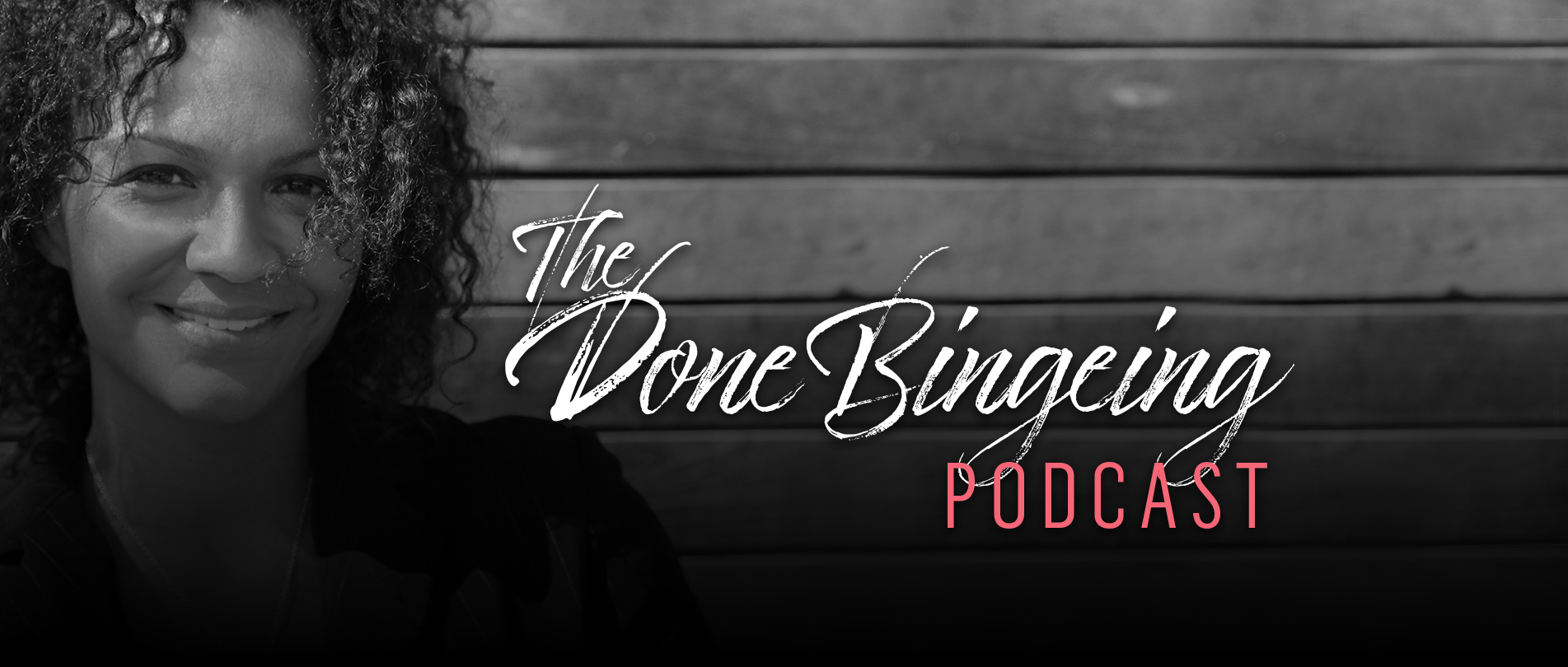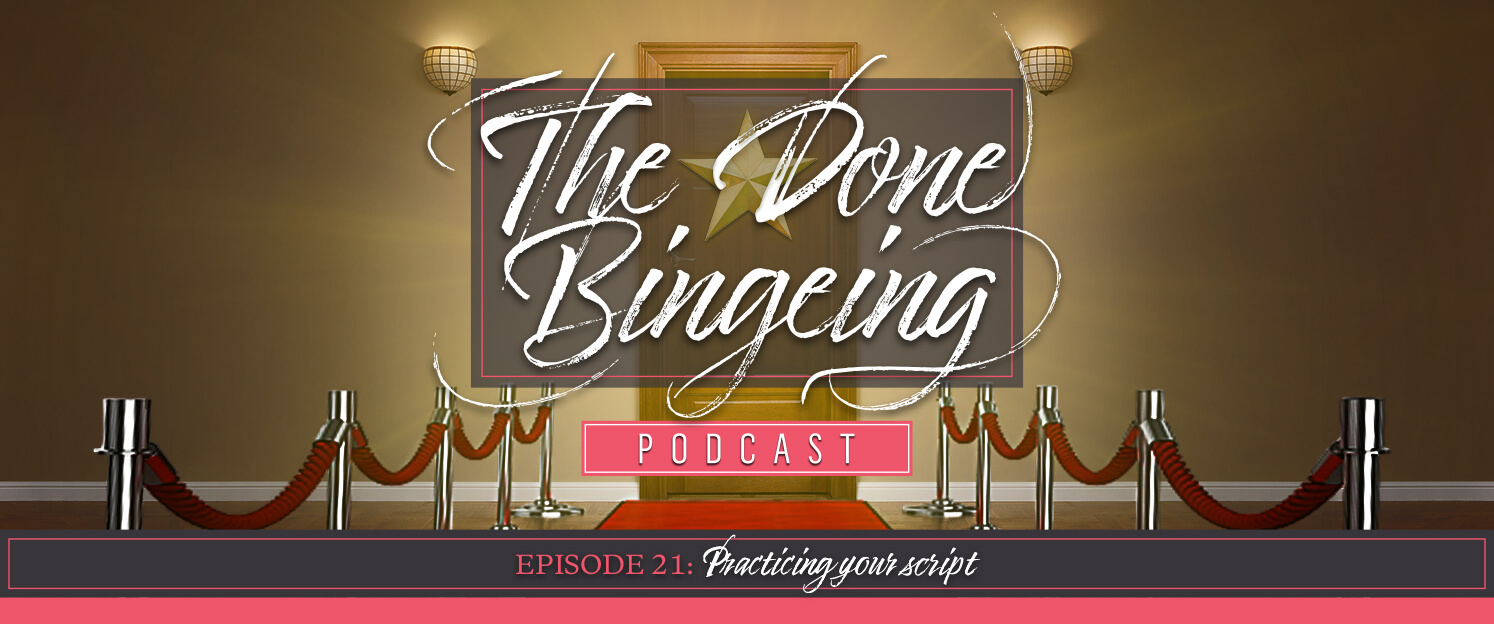
EP #21: Practicing your script

You’ve written your script—the list of thoughts that describe who you truly are and who you truly want to be. Showtime is coming. The set is being built. The props are being purchased. The lights are being hung. Auditions are underway for the supporting actors. And you just got the rehearsal schedule: you’re due to practice every day, at least twice. You want to know your lines inside out so that you can live your character, not robotically, but seamlessly. It’s easy to recite your lines to the mirror, holding your script in front of you in the privacy of your own dressing room. It’s another to do it on stage in full make-up and costume, with the crowd watching, the lights blinding, and the pressure building. And that’s why you’re practicing your thoughts. So that the next time you pass the corner bakery with the tiramisu that you swear calls you by name, you’ll be ready. The next time you come home from work exhausted and restless, bored and lonely, you’ll be ready.
Get full show notes and more information here: https://www.holdingthespace.co/21
Episode: Play in new window
Subscribe: iTunes | Google Play | Stitcher | RSS
- Why you need to practice your script as much as possible.
- Why it matters when you practice.
- Why that stack of sticky notes hanging around in your desk drawer is about to come in handy.
- Why you may want to consider putting up some new wallpaper.
- How practicing your thought will get you ready for the next trigger to overeat.
Why is your name engraved on a golden star on a dressing room door? And why is the handle turning? Keep listening!
Welcome to The Done Bingeing Podcast. This is the place to hear about how you can pair the emerging brain science about why you binge with powerful life coaching to help you stop. If you want to explore a non-clinical approach to end binge eating, you’re in the right place. It’s time to free yourself. You have more power than you know. And now, your host, Life and Weight-Loss Coach Martha Ayim.
Welcome to Episode 21 of The Done Bingeing Podcast. We’re back together again, and I’m so glad!
At the risk of oversharing, there’s probably a little more you should know about me—I’m a recovering knitter. I’m also a recovering crocheter and macramér.
Growing up, I was surrounded by yarn, needles, hooks, and beads.
My mother knit sweaters on a dime. The moment a boyfriend went from sketchy to legit, he had a sweater. The second the pee hit the stick and it was an affirmative, the first row of a baby sweater was cast on for some relative or some friend or some neighbor—basically anyone that my mom heard about who was pregnant. My mom was not to be outdone by my grandmother, of course, who kept pace with crocheted blankets, afghans, and throws. Then there was my father, who macraméd wall hangings and plant hangers.
Every household we visited had a knitting bag with a project on the go. On the way to visit those households, whoever wasn’t driving clicked away on the odd mitten or sock or hat. Each town, it seemed, had its own group, often named some variation of Stitch’n’Bitch or Bitchin’ Stitchin’. There were arguments over which needles were superior: wood or metal or plastic. Kafuffles over which yarn washed up the best: acrylic or wool or cotton. And multiple commiserations about whatever happened to Phentex. When they disappeared, you couldn’t find a yarn to knit a slipper worth making.
Whenever someone got stuck—on either a new stitch or a faulty pattern—everyone stopped and crowded ’round. Special glasses were lifted off the tops of heads and heaved up from the depths of cleavage. Bright lights were switched on, flashlights fixed onto the stitch in question. Multiples theories and solutions were proposed and tried until, at last, all was well and the wool wove through again, onward to the end of the row.
We would drive for hours to get to a legendary yarn outlet in Listowel, a small Ontario town two hours west of Toronto. There, at great cost savings, Mom and Granny would buy skeins of yarn—the term they used at the time for a huge loop that often contained hundreds of meters of yarn inside. Once home, the skeins—now, generally called hanks—needed to be wound into a series of manageable-sized balls. This was a production that was a lot less complicated when the cat was asleep and before anyone had yet declared it “noon somewhere” and brought out the libations. The balling of the skeins typically involved three of us, one to hold one end of the skein, one to hold the other, and one to walk from end to end unwinding the yarn from the skein and rolling it into balls.
There was something about the way the yarn moved through my fingers as I knit; something about the pull and the pause; something about belonging to this crafty club; something about the faith required in someone else’s map—a graph of crosses and dots that promised a sweater with a Monet masterpiece on the back.
I used to love to knit at midnight when re-runs of the X-files came on the Space channel. I usually dropped a stitch whenever Fox Moulder was on screen—and he was on screen a lot.
I learned that I had a peculiar love for what most knitters hated—the task of sewing in loose ends. Every transition to a new ball of yarn was marked by two loose ends—one from the old ball, and one from the new one. With a complicated, multicolored pattern, there were a lot of ends. It was a time-consuming task that required focus. And if the required attention wasn’t paid, a sweater or throw would show it, perhaps not right away, but soon enough, when just enough of life had pulled in and out of the sleeves or crawled under and out from the warmth.
Sewing in the ends was a big job if left as the final task, and so I liked to sew in the ends as I went. I carried a darning needle with me everywhere so I’d never have to leave an end dangling. While I carried that needle, I thought I had a service I could offer to the world—to sew in ends that’d become lose on other people’s sweaters and socks. But not everyone appreciated what I thought was such a generous act. And after one man grumbled in bare feet while I darned his socks, I got it, and started to mind my own business and mend my own projects. Although I learned that lesson, I never lost the irritation that came with a loose thread. It always unsettled me, and still does.
And, so, this is a very long, possibly very boring, explanation of why my podcast flows the way it does.
We met in Episode 1, committed to our work in Episode 2, and since Episode 3 we’ve basically taken a loose end and woven it in. That loose end was self-regard. It’s a profound piece of resolving binge eating often left out of the central discussion.
We’ve been following the thread of self-regard through six key challenges that binges eaters often experience:
1. Unhappiness with weight—we considered this in Episode 4
2. Dieting to lose that weight and to control eating—we explored these in Episode 5
3. Urges to binge—we looked into this in episodes 6 through 8
4. The bingeing itself—we tackled this in episodes 9 and 10
5. The post-binge blues—we dove into this in Episode 11, and
6. Losing excess weight after bingeing has stopped. Here is where, in Episode 12, we began to discuss the desire to overeat. In that episode, we sketched out three main reasons why we have the desire to overeat in the first place:
1. we use food to anaesthetize painful emotions
2. our eating is conditioned by society, and
3. our dopamine system gets hijacked by high-sugar foods
In Episode 13, the thread wove into a conversation about emotional eating and we’ve actually been following that thread ever since. We talked about eating feelings versus feeling them. We talked about understanding feelings and creating feelings by thinking deliberately. The reason we began to explore thinking is because thoughts create our feelings. And, so, we dove deeper into deliberate thinking by focusing on mental hygiene—aka cleaning up our thoughts. And, recently, we’ve been exploring what it means to think your way to where you want to go, and what it means to look beyond the end of your bingeing. This has been the core of our focus on mental rehearsal so far—on writing your script, and now, eventually, if I ever shut up, on to practicing your script.
So, we’re on one heck of a long thread. But it’s been worth following for 19 episodes and counting because it has shown us the power of self-regard.
In the last episode, you wrote your script—the thoughts you need to think to create the feelings that will inspire you to show up in your life the way you truly want to.
Showtime is coming. The set is being built. The props are being purchased. The lights are being hung. Auditions are underway for the supporting actors. And you just got the rehearsal schedule.
Damn. Every day? Seriously?
Let’s stop for a second. Why are we bothering? Don’t you have better things to do with your time than practice thinking?
Maybe you do.
Not everyone needs “all this stuff” to stop binge eating.
For some binge eaters, simply accepting their weight is all they need to do to stop binge eating. For others, simply ending the diet is all they need to do to stop bingeing. For yet others, learning to allow and witness urges, learning to welcome them then defuse them, is enough to end the bingeing. That’s why the early episodes focused on those issues right away.
If you’ve been able to stop bingeing by loving your beautiful body as it is right now, by ending the dieting, or by letting the urges come and go in your life without interference, nice work!
And if, like some listeners, you’ve seen progress just from these earlier episodes, that’s wonderful. Keep at it, it just takes practice. That may be all you need to do. You don’t need to keep listening if you don’t want to. Just keep returning to the practice of stepping back from the urge and watching it surge and recede on its own.
In my journey, however, I needed to go further.
My binges didn’t end with acceptance of my curves.
They didn’t end with the end of dieting.
And they didn’t end with watching the urges come and go like the moon-time tide.
They ended when I understood the role my thinking played in my bingeing. They ended when I applied ninja life coaching tools to what I’d learned from brain science. They ended when I was open to exploring what a life without an obsession with bingeing, food, and weight would be like.
So, if you’re still with me, and if you’re still willing, let’s keep going. And, as always, take what’s useful and toss the rest.
You have your script and a daily rehearsal schedule.
Now, it’s time to practice your script until you have it memorized. You want to know your lines inside out so that you can live your character, not robotically, but seamlessly. It’s easy to recite your lines to the mirror, holding your script in front of you in the privacy of your own dressing room. It’s another to do it on stage in full make-up and costume, with the crowd watching, the lights blinding, and the pressure building.
That’s why you’re practicing the list of thoughts that describe who you truly are and who you truly want to be. Because the next time a colleague asks if you’ll buy a chocolate bar to help her cute little five-year-old fundraise for her school, you’ll be ready. The next time you pass the corner bakery with the tiramisu that you swear calls you by name, you’ll be ready. The next time you’re checking out at the grocery store and there’s a two-for-one sale on chips, you’ll be ready. The next time a deadline looms and you’d like to be doing anything other than the work required, you’ll be ready. The next time you come home from work exhausted and restless, bored and lonely, you’ll be ready.
To be ready, you need to have your thoughts at the forefront of your mind, available to your higher brain, accessible by your prefrontal cortex in a flash. To be ready, you need to practice your thoughts.
Start by brainstorming all the places where it would be helpful to post or store copies of your list of key thoughts. Maybe you could post them on your bathroom mirror, on your refrigerator door, or on a kitchen cabinet. Maybe you could lay them on your bedside table, on the floor by your shoe mat, or on the landing going upstairs. Maybe you could keep a copy in your glove compartment, in a desk drawer, or in a purse. If you want to decorate your lists or use fancy fonts or papers, go right ahead, just have them ready for you to practice when you have a moment.
You might consider taking a photo of your new thoughts with your cell phone and making this photo your new wallpaper. You might consider making your thoughts into a screensaver on your computer. You might consider entering your thoughts inside an appointment on your cell, and set it to go off twice a day to remind you to practice. Practicing your thoughts twice a day is a great start. Of course, more is better. And the more you can practice them when you’re not in a triggering situation, the better you’ll be able to handle a trigger when it comes. Because for sure, one’s coming.
So much of what I learned on my journey to end my bingeing, I had already learned from knitting.
What I learned from knitting was this:
I learned that I had a script. In the beginning, it came from those who had knit things I hadn’t yet knit. And in the end, I wrote and followed my own patterns in my own time. But what mattered more than who had written the pattern was whether the pattern helped me create what I wanted to create.
I learned that when I was distracted or went unconscious when Moulder appeared or when life happened, I dropped stitches. It didn’t mean that anything was ruined. It simply meant that I needed to go back over that row until I found what I’d lost, until I’d recovered it and woven it back in to the whole once more.
I learned that I could get help if I needed it. There were others who had gone before me who were often willing and able to help.
I learned that knitting embodied many dualities: utility and art, solitude and community, frustration and perseverance, knowledge and faith.
I learned that the sweaters and blankets came out of a practice of doing the same thing over and over and over: knit of the front side, purl on the back for a smooth texture; knit two, purl two for the ribbing on the cuffs and collars.
I learned that there was something about the weaving, the in and the out, the twists and the turns, row on row, that built steadily toward something I could not always see from the beginning, despite having a pattern of promise.
And I learned that if I took my knitting bag with me everywhere, I could knit almost everywhere and I could irritate almost no one. One stitch after another, knit from one available moment after another, possibly consecutively, possible not, became row upon row, and, in the end, a creation of warmth that held together more than yarn, that told more than my own yarn, and that presented on the back the promised pastel lilies on the pond.
Take your thoughts with you everywhere. On paper for now if you need to. Then, eventually, just in your mind, always within the reach of consciousness, at the ready to create what you want to create.
That way, when the curtain goes up and the lights come on, you’ll be ready.
You are worth thoughts that serve you.
And you are worth the time it takes to practice them.
That’s it for Episode 21. Thank you for listening. The Done Bingeing Podcast is helping so many people to reduce their bingeing and overeating, and to find out who they’re truly meant to be when they live their lives fully. Ratings and reviews will help more people find this podcast and get the help they need. So, if you’re getting something out of this podcast, I would be honored if you would leave me a rating and review. Just go to www.holdingthespace.co/itunes-review for easy-peasy instructions on how to get it done. Thank you so much!
Thanks for listening to The Done Bingeing Podcast. Martha is a certified life and weight loss coach who’s available to help you stop bingeing. Book a free session with her at www.holdingthespace.co/book. And stay tuned for next week’s episode on freeing yourself from binge eating and creating the life you want.
- Never miss an episode by subscribing via iTunes, Stitcher, Google Play, or RSS.
- Leave a rating and review in iTunes.
- Have a question or topic you’d like to see covered on the podcast? Send it on over to support@holdingthespace.co.
- If you found this episode valuable, it would mean so much to me if you would please share it with your friends.
- Where are all the places where it would be helpful to post or store copies of your list of key thoughts?
- What two times of day would be good times for you to practice your thoughts?
Thank you so much for sharing your thoughts with me.
Sending much love to you!






















0 Comments